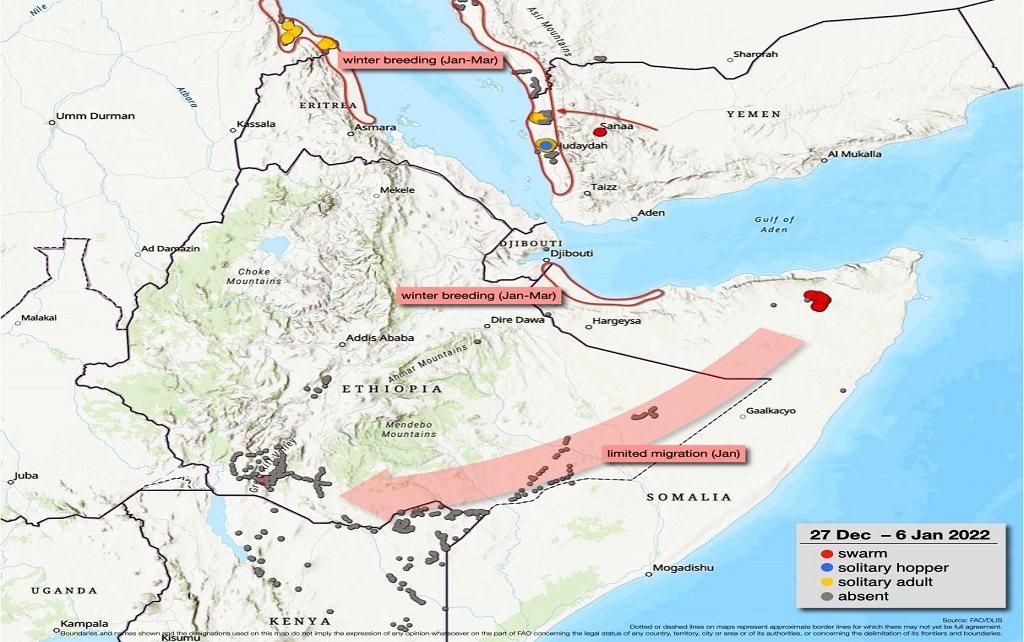7 December 2022. Small outbreak in Mauritania
KEY POINTS
• Current situation: calm in all regions
• November: a small outbreak developed in early November in an area of about 100 km by 70 km in northwestern Mauritania
• December-mid January: slightly above-normal rainfall may occur in the northern parts of the Red Sea coast in northern Saudi Arabia, Egypt, and Sudan. As a result, a single generation of small-scale breeding is likely during the winter
The Desert Locust situation continued to remain calm during November.
A small outbreak developed in early November where hoppers, groups, and bands were seen in an area of about 100 km by 70 km in northwestern Mauritania. Ground teams treated 2 298 ha. In Sudan, low numbers of adults were first seen in the winter breeding areas this year along the Red Sea coast where a few copulating had started. Isolated adults were else seen in coastal areas of Eritrea, southeast Egypt, and northwest Somalia. In Yemen, low numbers of adults have been on the coast since September. During the forecast, December and January may have slightly above-normal rainfall in the northern parts of the Red Sea coast in northern Saudi Arabia, Egypt, and Sudan while southern areas from Eritrea, southern Saudi Arabia, Yemen, and northern Somalia will be drier than normal. As a result, a single generation of small-scale breeding is likely during the winter. In northwest Mauritania, groups of adults are likely to form in December but should decrease due to control, vegetation that dries out, and rain which is not likely to occur. No significant development is likely to happen.
Surveys and vigilance should be maintained in the winter breeding areas.
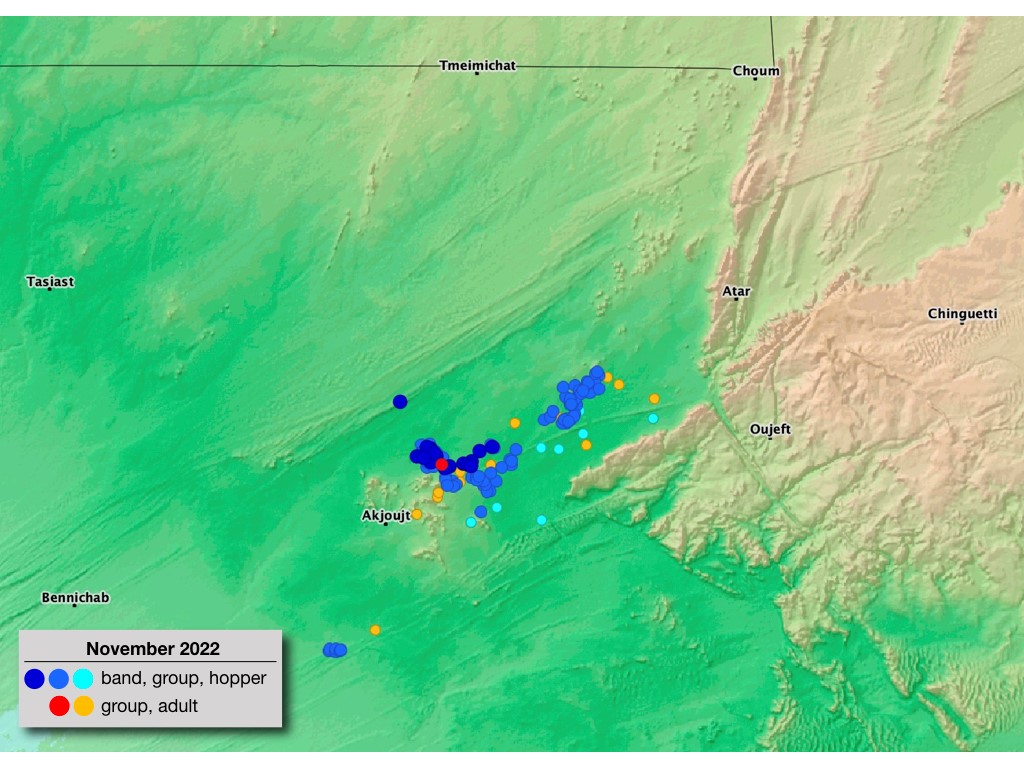
7 November 2022. Summer rains and breeding end
KEY POINTS
• Current situation: calm in all regions
• October: summer rains finished and summer breeding was nearly none
• November-mid December: locust numbers will appear and increase slightly in the Red Sea coast of Sudan, Eritrea, Yemen, Saudi Arabia, and maybe southeast Egypt and the coast of northwestern Somalia.
The Desert Locust situation continued to remain calm during October.
Low numbers of solitarious adults and a few hoppers were seen in parts of Mauritania, Niger, Chad, Sudan, and Yemen. In northwest Mauritania, few groups of copulating adults and transiens hoppers occurred and 213 ha were treated. In Sudan, one group of adults were seen on the west of the Red Sea Hills. In pre-winter areas, light rain fell at time on the Red Sea coast of Yemen and started to rain in the parts of the coast of Sudan, Eritrea, and Saudi Arabia. No rain or locusts were in Southwest Asia. During the forecast, locust numbers will appear and increase slightly in the Red Sea coast of Sudan, Eritrea, Yemen, Saudi Arabia, and maybe southeast Egypt and the coast of northwestern Somalia. Small-scale breeding is locally to start but should remain low in the winter area and no significant developments are likely. In northwest Mauritania, breeding will occur and a few more groups can form.
Surveys and vigilance should be maintained in the winter breeding areas.
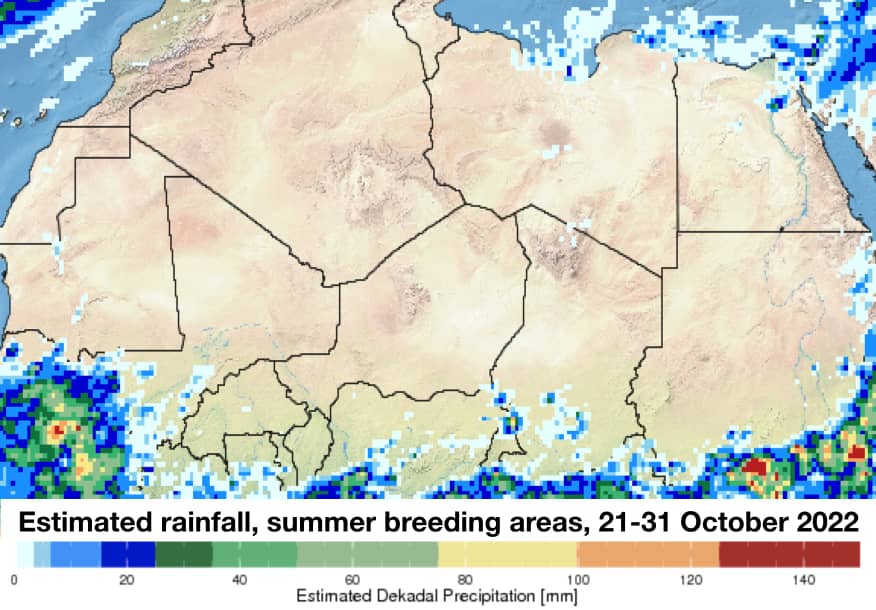
4 October 2022. Summer rains decline in breeding areas
KEY POINTS
• Current situation: calm in all regions
• September: light to moderate rainfall continued in the northern Sahel with decline in the second half of the month and withdrawal of the southwest monsoon in Indo-Pakistan border
• October: locust numbers decrease in the summer breeding areas with likely to slight increase in areas of northwest Mauritania and the Red Sea coast of Yemen
• November: potential locust increase in coastal plains in Sudan, Saudi Arabia, Eritrea and Egypt
The Desert Locust situation continued to remain calm during September.
Only low numbers of solitarious adults persisted in Mauritania, Niger, Sudan, and Yemen. Few hoppers were seen in parts of northwest Mauritania and in the Red Sea coastal plain of Yemen. Light to moderate rainfall continued in the northern Sahel but was declined during the second half of the month from Mauritania to western Eritrea, and vegetation started to dry out in many places. Similarly, the withdrawal of the southwest monsoon finish in Indo-Pakistan border during the last week of September. During the forecast, locust numbers will continue to decrease in the summer breeding areas but are likely to increase slightly in current areas of northwest Mauritania and in the Red Sea coast of Yemen and start to appear in the coastal plains in Sudan, Saudi Arabia, and maybe Eritrea and Egypt from November onwards. Consecutively, the locusts will continue to be remain well below threatening levels and no significant developments are likely.
Regular surveys should be maintained in the breeding areas.

6 September 2022. Summer rains continue in many areas
KEY POINTS
• Current situation: calm in all regions
• August: moderate to heavy rains continued summer breeding areas
• September: small-scale breeding will occur in in summer breeding areas for
with above-normal rains
• October: potential locust increase in African Sahel, western Eritrea, Yemen, Indo-Pakistan border
The Desert Locust situation continued to remain calm during August.
The Desert Locust situation continued to remain calm during August. Only low numbers of solitarious adults were seen in a few places in southeast Mauritania, Niger and Yemen. The seasonal rains continued in August in the summer breeding areas from Mauritania to Eritrea. Heavy rain fell in southeast Pakistan and in parts of the Red Sea coastal plains in Yemen and southwest Saudi Arabia as well as a few places in Sahel. Vegetation became green from the beginning of August in most places. During the forecast period, small-scale breeding will occur in the northern Sahel from Mauritania to western Eritrea and along both sides of the Indo-Pakistan border. It be also occurred near the Red Sea coastal of Yemen. This will cause locust numbers to increase slightly, but remain well below threatening levels.
Vigilance and regular surveys should be maintained in the summer breeding areas.
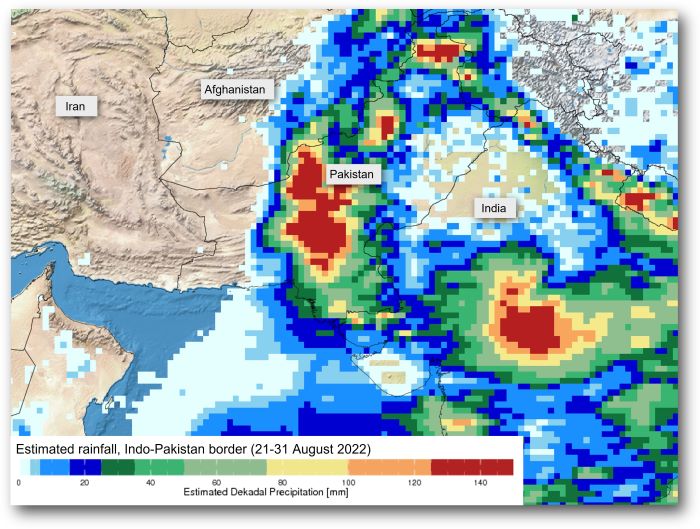
11 August 2022. Summer rains started in summer breeding areas
KEY POINTS
• Current situation: calm in all regions
• July: rains started in summer breeding areas
• August–September: above-normal rains likely in summer breeding areas for small-scale breeding
• October: potential locust increase in African Sahel, Yemen, Indo-Pakistan border
The Desert Locust situation continued to remain calm during July.
Only low numbers of solitarious adults and hoper groups were reported from different sites in the summer breeding areas in the interior of Sudan, and few isolated immature solitarious adults were reported in the summer breeding areas of Marib Governorate in Yemen.
July was characterized by the heavy rains in the Sahel region (Mali, Niger and Mauritania), Oman, Yemen and India (Gujarat, Bikaner and Nagaur). Moderate rainfalls were recorded in the North African countries (southern Algeria, Libya and Morocco). Moderate to high rains fell in Eritrea, Ethiopia, Pakistan, Saudi Arabia, Somalia (Somaliland), and Sudan, while low to moderate rains fell in Djibouti and Egypt.
The rains fell during July in the breeding areas have contributed to the creation of favourable ecological conditions (vegetation and soil moisture) for locust breeding, where vegetation was found greening/green and soil was observed to be wet or moist in breeding areas in several countries.
As the predictable weather models indicated above-normal rains are likely in summer breeding areas during August and September, small-scale breeding will occur in the northern Sahel from Mauritania to western Eritrea, and in breeding areas with sufficient rainfall, particularly in Sudan and Yemen, and along both sides of the Indo-Pakistan border. Limited breeding may also occur in northeast Ethiopia and Somalia if good rains fall during the forecast period.
These breeding activities will cause locust numbers to increase slightly by the end of the forecast period
Vigilance and regular surveys should be maintained in the summer breeding areas.
.jpg)
1 July 2022. Summer rain starts in some areas
KEY POINTS
• Current situation: calm in all regions
• June: rains started in summer breeding areas
• July–September: above-normal rains likely in summer breeding areas for small-scale breeding
• October: potential locust increase in African Sahel, Yemen, Indo-Pakistan border
________________________
The Desert Locust situation continued to remain calm during June.
Only low numbers of solitarious adults persisted in southeast Egypt and near irrigated areas in the Sahara of Algeria. No control operations were required during the month.
Due to a persistent La Niña, seasonal rains commenced earlier than normal as expected in some southern parts of the summer breeding areas in the northern Sahel between Mauritania and western Eritrea. Rains were heavier and widespread in Mauritania. Nevertheless, vegetation remained mostly dry but was starting to become green in parts of central Niger, the interior of Sudan, and eastern Ethiopia.
In response to a negative Indian Ocean Dipole, pre-monsoon rains fell in some areas along the Indo-Pakistan border that should cause annual vegetation to become green.
During the forecast period, small-scale breeding will occur in the northern Sahel from Mauritania to western Eritrea and along both sides of the Indo-Pakistan border. This will cause locust numbers to increase slightly but remain well below threatening levels. Limited breeding may also occur in northeast Ethiopia and in the interior of Yemen if rains fell during the forecast period.
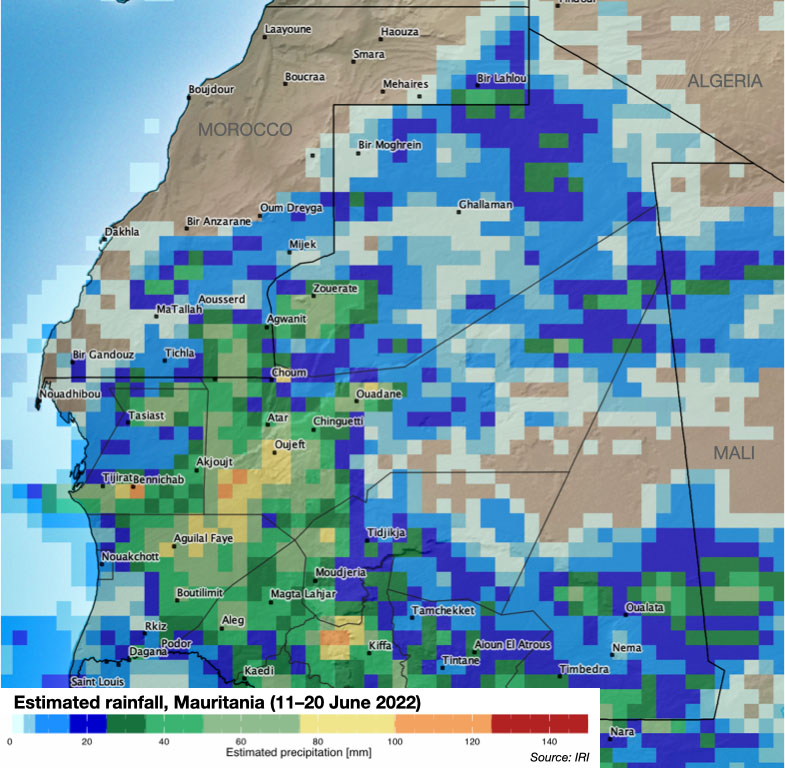
1 June 2022. Calm situation prevails
KEY POINTS
• Current situation/forecast: calm in all regions
• May: no rainfall, dry vegetation, and few locusts
• June: low risk of small-scale breeding in E Ethiopia
• July–September: above-normal rains likely in summer breeding areas for small-scale breeding
• October: potential locust increase in African Sahel, Yemen, Indo-Pakistan border
________________________
The Desert Locust situation continued to remain calm during May.
Ecological conditions were dry and unfavourable for breeding in all regions because of a lack of rainfall. Small locust infestations were present in southeast Egypt and southwest Pakistan.
In Egypt, hoppers and adults concentrated in the little vegetation that remained green near the Red Sea coast and formed several small groups that were treated. There is a limited risk that any undetected adult groups could move south to cropping areas in the Nile Valley in northern Sudan.
In Pakistan, a few spring-bred solitarious adults were present on the southwest coast.
During the forecast period, small-scale breeding is likely to commence in the summer breeding areas of the northern Sahel between Mauritania and western Eritrea and along both sides of the Indo-Pakistan border. Limited breeding may also occur in the interior of Yemen and perhaps in parts of eastern and northeast Ethiopia. These areas are likely to receive above-normal rains from July to September due to a persistent La Niña and a negative Indian Ocean Dipole that are expected to intensify further.
Nevertheless, it would take several generations of successful breeding before locust numbers could increase to threatening levels; hence, the situation is expected to remain calm to at least October.
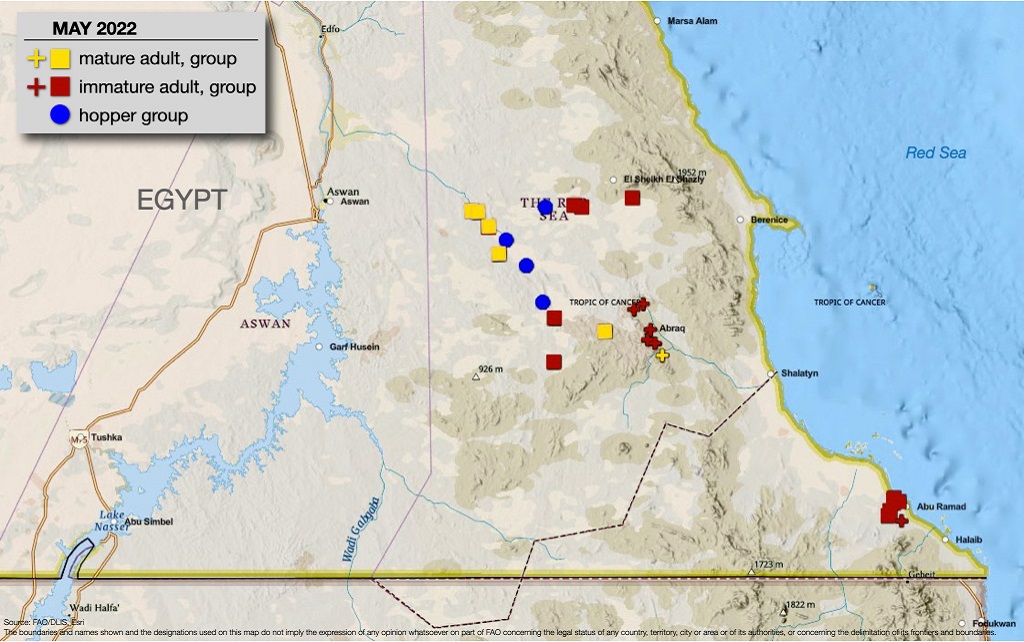
2 May 2022. Calm situation will continue
KEY POINTS
• Current situation: calm in all regions
• April: poor rainfall, dry vegetation, and few locusts
• May–June: no further spring breeding expected
• July–September: above-normal rains likely in summer breeding areas for small-scale breeding
• October: potential locust increase in African Sahel, Yemen, Indo-Pakistan border
_____________________________________________________
The Desert Locust situation remained calm during April as little rain fell and dry vegetation prevailed for a third consecutive month.
In the Horn of Africa, a few small remnant immature swarms remained during the first week in southern Ethiopia where they are likely to move north to eastern parts of the Somali region to mature and breed on a small scale in areas of recent rainfall.
Local hopper concentrations were treated in southeast Egypt, and isolated adults persisted on the southern coast of Yemen where they could move to the interior and breed on a small scale in areas that receive rainfall.
The annual joint survey covered 17 000 km in southeast Iran and southwest Pakistan and found only isolated adults and hoppers in a few coastal areas, confirming that very little breeding occurred this spring.
No locusts were reported in the Western Region.
The current situation will remain calm in all regions.
The longer-term outlook indicates an active early monsoon season along the Indo-Pakistan border and above-normal rainfall in the northern Sahel of Africa, the Yemen interior, and northeast Ethiopia from July to September. However, it would take several generations of successful breeding before locust numbers could increase to threatening levels; hence, the situation is expected to remain calm to at least October.
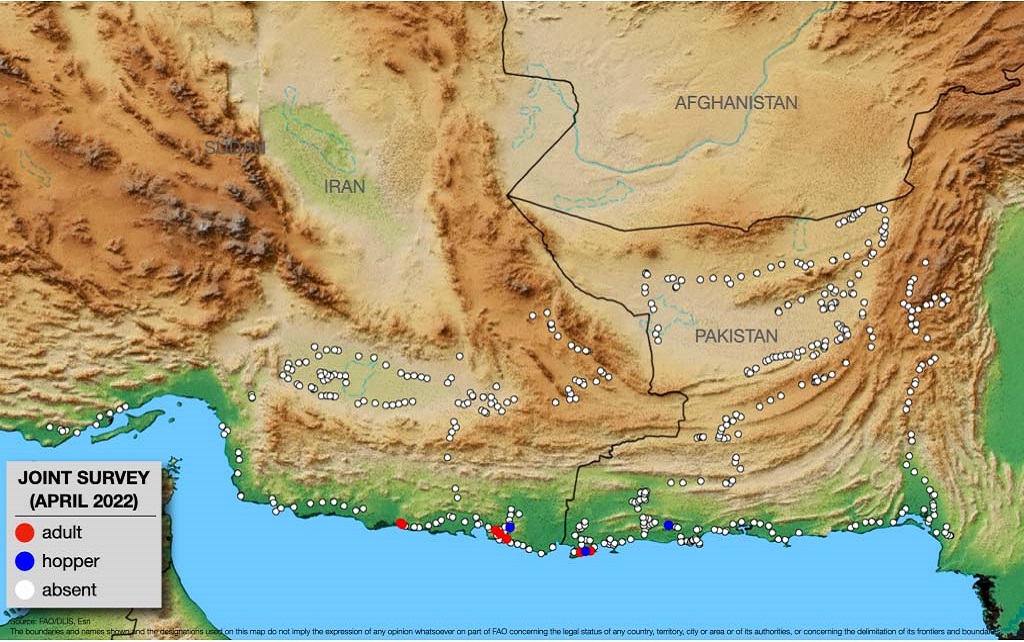
1 April 2022. Calm situation returns
KEY POINTS
• Current situation: calm in all regions
• March: poor rainfall, dry vegetation, and few locusts
• April–June: only limited spring breeding with no significant developments expected
• July–September: above-normal rains likely in summer breeding areas for small-scale breeding
• October: potential locust increase in African Sahel, Yemen, Indo-Pakistan border
_________________________________________________
The Desert Locust situation remained calm during March as little rain fell, vegetation was dry, and very few locusts were detected by surveys.
In the Horn of Africa, a few small remnant immature swarms were present in southern Ethiopia and aerial operations treated 400 ha. Any residual swarms that remain are not expected to mature and breed in the south; instead, they are more likely to move north towards the Somali region and eventually breed, but this may be limited by poor rainfall that is expected in the coming months. In any case, existing resources should be able to manage the situation.
Locusts declined in winter breeding areas along the Red Sea coast in Egypt and Sudan, and a few adults were seen on the southern coast of Yemen.
As very little rain is expected to fall this year in the spring breeding areas of northwest Africa, the Arabian Peninsula, and southwest Asia, no significant developments are likely between now and July.
The longer-term outlook indicates an active early monsoon season along the Indo-Pakistan border and above-normal rainfall in the northern Sahel of Africa, the interior of Yemen, and northeast Ethiopia from July to September. This might eventually lead to a potential increase in locust numbers in about October.
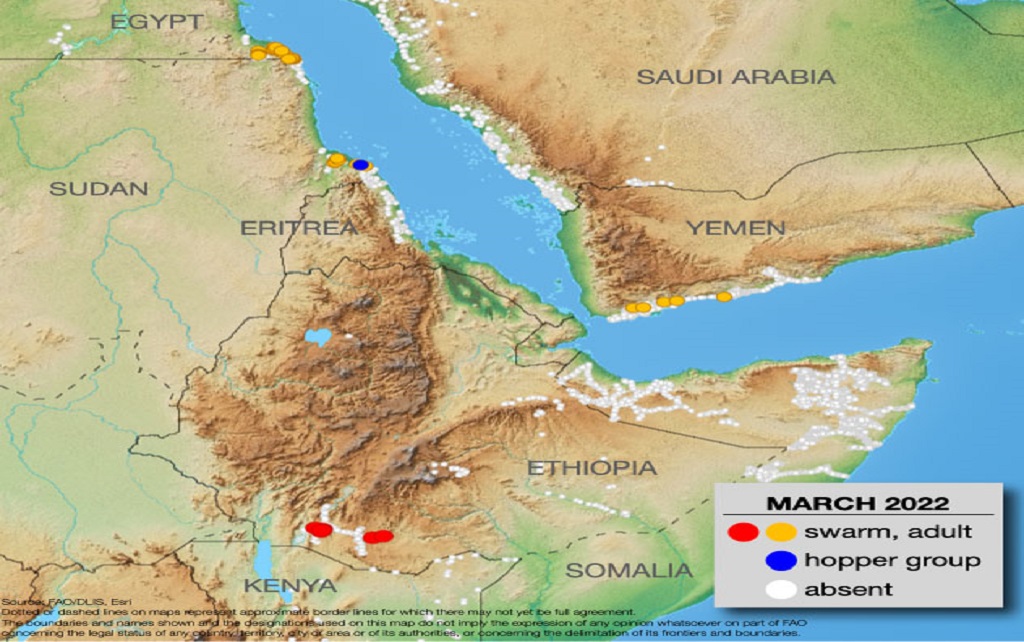
2 March 2022. Upsurge ends in the horn of Africa
The current Desert Locust upsurge has finally ended in the Horn of Africa after more than two years of intensive survey and control operations carried out by ground and air with generous support from the international community.
For nearly the second consecutive month, no significant locust infestations have been detected in Djibouti, Eritrea, Ethiopia, Somalia, and Kenya during February. Although rain has not fallen recently and ecological conditions are dry, small groups of immature adults were seen moving southwards in eastern Ethiopia, which suggests that a few residual infestations may still be present. Therefore, surveys and vigilance should be maintained.
This year’s winter breeding along both sides of the Red Sea and the Gulf of Aden has been very poor due to a lack of rainfall. Consequently, only low numbers of adults were present on the coast of Egypt and Sudan. Ground teams treated small groups of hoppers and adults in southeast Egypt, and isolated breeding occurred on the southern coast in Sudan.
Elsewhere, isolated adults were present in southern Algeria and northern Oman.
During March and April, low numbers of adults may appear in the spring breeding areas in Morocco, Algeria, the interior of the Arabian Peninsula, southeast Iran, and southwest Pakistan where poor rains are expected to limit breeding this year.
Consequently, the situation is expected to remain calm in the coming months.
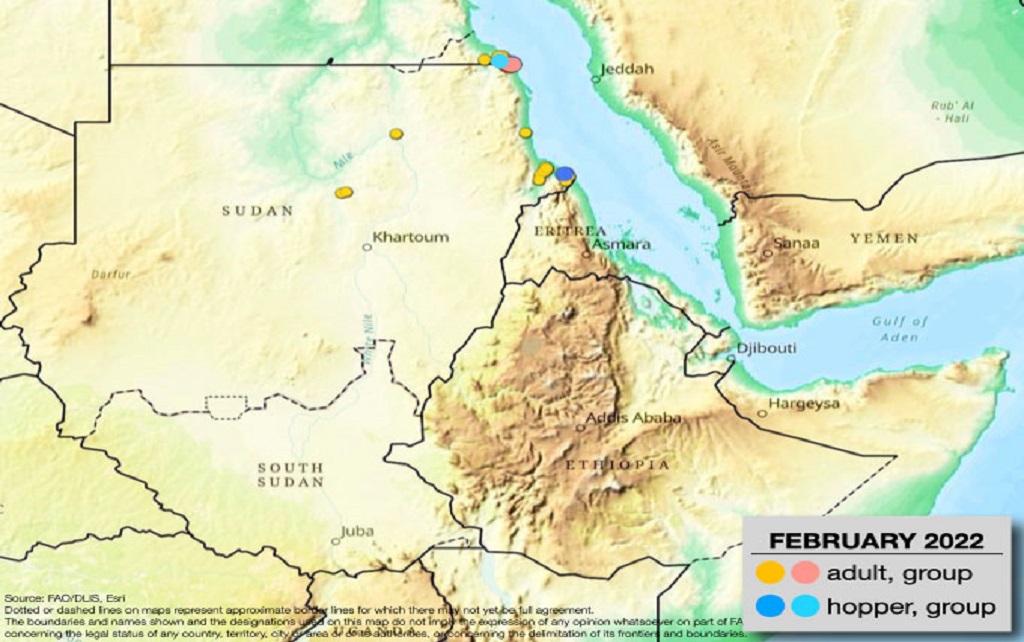
1 February 2022. Upsurge declines in the horn of Africa
After more than two years, the current Desert Locust upsurge has finally declined.
Aerial control operations against the few small immature swarms that remained in northeast Somalia ended on 4 January. During the remainder of the month, no locusts were seen in Ethiopia and Kenya, and southerly migration was not detected. As ecological conditions are dry due to a lack of rainfall in the Horn of Africa, the likelihood of any further developments in the region is low but vigilance is suggested during February.
Adding to the collapse of the upsurge, poor rains have limited winter breeding to a small area along both sides of the Egypt/Sudan border on the Red Sea coast. While small-scale breeding may occur during February on the coastal plains near the Sudan/Eritrea border and in a few places on the Saudi Arabia and Yemen coast, it is likely to be limited and should not cause a significant increase in locusts.
Elsewhere, the situation remains calm.
Small-scale breeding is likely to commence during February and March in the spring breeding areas of southeast Iran and southwest Pakistan where early rains fell in January, and south of the Atlas Mountains in Morocco where isolated adults are currently present. No significant developments are expected, and the situation should continue to remain calm and return to normal.
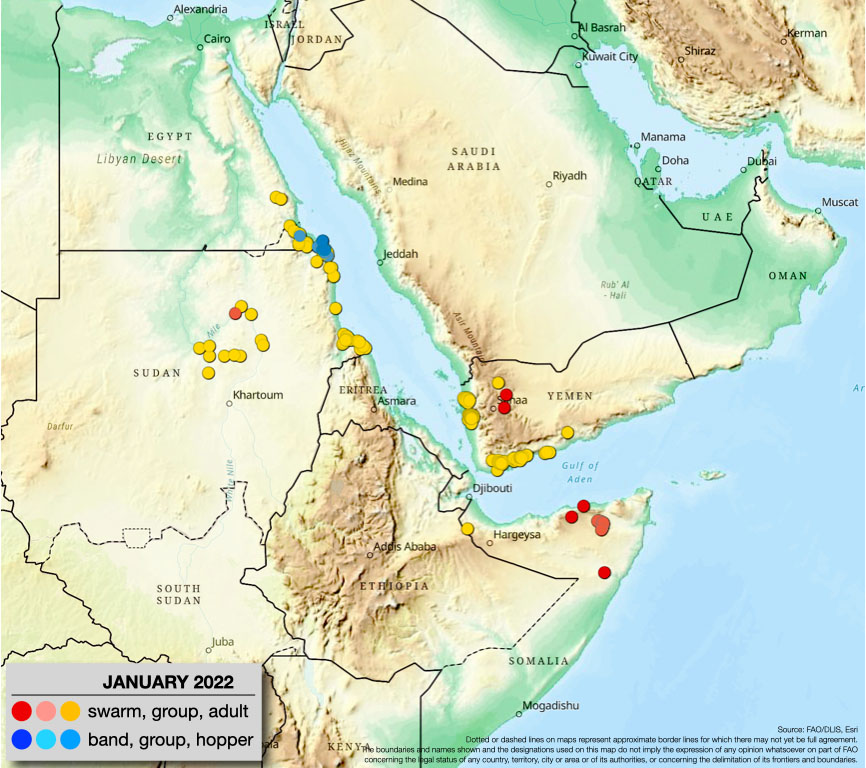
6 January 2022. Small swarms persist in NE Somalia
OVERVIEW. Control operations are continuing against a limited number of small immature swarms in northeast Somalia that formed last month from local breeding. During the last week of December, a few swarms probably migrated towards the southwest and reached the edge of the Rift Valley in southern Ethiopia where they were reported on the 28–29th. Since then, there have been no signs of additional migration towards southern Ethiopia and northern Kenya. Elsewhere, low numbers of solitarious adults are present along both sides of the Red Sea where winter breeding has started in Yemen and southeast Egypt.
WHY IT MATTERS. The control operations carried out in northeast Somalia during the past month have dramatically reduced the number of swarms that formed in the past three weeks. Nevertheless, a few immature swarms are still present in the northeast where they are likely to remain a bit longer than expected because local winds are concentrating them between Garowe, Las Anod, and Erigavo and delaying their anticipated migration south-westwards across eastern Ethiopia to the border of Kenya. As conditions are drying out in northern Somalia, limited swarm movement is still expected to occur. If any swarms reach the Kenya/Ethiopia border, easterly and southeasterly winds are likely to carry them towards the Rift Valley in northern Kenya and southern Ethiopia, preventing movement further south into central Kenya. Consequently, vigilance and preparedness should be maintained in northern Kenya and southern Ethiopia throughout January in case any additional small immature swarms appear from the northeast. The current level of resources should be sufficient to control the swarms before they become mature and ready to breed when the long rains commence in about April. Elsewhere, no significant developments are expected along both sides of the Red Sea.
CONTEXT. Compared to the past two years, the potential invasion of swarms in northeast Kenya is later this year because they are only present in northeast Somalia and not in eastern Ethiopia and central Somalia where prevailing winds tend not to impede their migration. The threat to Kenya this year is less dangerous and on a much smaller scale.
TAKEAWAY. The current upsurge continues to show optimistic signs that it is declining further.
• Central Region (SERIOUS) – maintain operations (Ethiopia, Somalia) and vigilance (N. Kenya)
• Western Region (CALM) – no significant activities
• Eastern Region (CALM) – no significant activities
